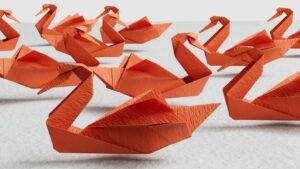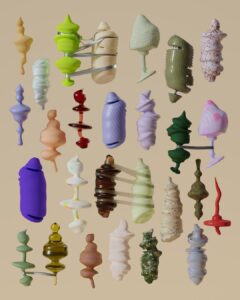Support our educational content for free when you purchase through links on our site. Learn more
How Do You 3D Print Something in 2023?

Welcome to 3D Printed™, the ultimate guide to things to 3D print. In this article, we will tell you how to 3D print something from scratch and answer some of the most frequently asked questions on the subject. By the end of this article, you will learn how to 3D print anything you want even if you don't have any prior experience.
What Is 3D Printing?
3D printing is a process of creating a three-dimensional physical object from a digital model by adding successive layers of material. It is also called additive manufacturing, because unlike traditional manufacturing processes (subtractive, where material is removed from a block of a given material), it doesn't involve removing the material you don't need to create the desired object. You can use a 3D printer to make anything from toys to house appliances and even detailed models of various parts.
3D printing is changing the way people think about design, manufacturing and creation. It is empowering people to reimagine and redesign components that previously were considered impossible to model.
Steps of 3D Printing
Step 1: What Do You Need for 3D Printing?
Before getting started with 3D printing, you will need some specific materials and equipment, especially if you're going to be doing any 3D modeling. Here's what you will need:
- A 3D printer: There are tons of 3D printers available in the market today. The most popular types of 3D printers are FDM (Fused Deposition Modeling), SLA (Stereolithography), SLS (Selective Laser Sintering), and LOM (Laminated Object Manufacturing) printers.
- 3D modeling software: Some 3D printers come with built-in software, but it might be better to use software specifically designed for 3D printing such as Blender, Fusion360, Tinkercad, Sketchup, etc.
- Printing materials: The most popular material for 3D printing is PLA (polylactic acid), a biodegradable and easy-to-use plastic. Other materials include ABS (Acrylonitrile Butadiene Styrene), Nylon, Polycarbonate, and TPU (Thermoplastic Polyurethane).
- A slicer: This is a software program that converts your 3D model into specific instructions for the printer.
Step 2: Prepare the 3D model
Now that you have your tools and materials ready, it's time to design a 3D model. You can create a 3D model using CAD (Computer Aided Design) software or you can download one from an online database such as Thingiverse or MyMiniFactory.
Step 3: Import the 3D model into a slicer
After designing the model, it’s time to import it into the slicer program. A slicer automatically generates the instructions for the printer, such as the proper bed temperature, how much plastic to use, how fast the print head should move, etc.
Step 4: Slice the model
Once you have imported the 3D model into the slicer, it's time to slice it. Slicing means the 3D model is divided into horizontal layers that the 3D printer will use to create the physical object.
Step 5: Choose the right print settings
For best results, choose the right print settings that match your 3D printing material and printer. This will ensure that the final printed product will look perfect and be of the highest quality.
Step 6: Begin printing
Once you have chosen the right settings, it's time to press the print button on the 3D printer. The printer will start creating the object from the bottom up, layer by layer.
Step 7: Remove the 3D Print
Once printing is complete, remove the object from the printer build plate. Depending on the material, you might need to use a special tool to do this.
Step 8: Post-processing
After 3D printing, post-processing steps include sanding, polishing, coating, painting, or adding decals to the 3D-printed object. It's all up to your personal preference and intended use.
3D Printed™ Quick Tips and Facts
- If you're using PLA as your 3D printing material, keep in mind that the cooler temperatures help prevent warping and splitting issues.
- Nylon material is tough and resistant but might be difficult to print due to its high melting point, hence needs a high-temperature extruder.
- When printing with ABS, it is important to keep the printing bed heated because ABS tends to warp during the cooling process.
- Layer height and print speed can make a huge difference in the quality and details of the final 3D print.
- Before printing a large object, make sure to print a small section first to check the quality before embarking on a larger project.
Frequently Asked Questions
How 3D Printing Works Step by Step?
3D printing works by taking a digital 3D model and translating it into a series of instructions that a 3D printer can understand. The 3D printer then uses a spool of printing material to lay down successive layers until the final object is created. This process is called "additive manufacturing", because it adds material to create the final object, compared to subtractive manufacturing where material is removed to shape the final object.
How Do I Convert an Image to 3D Print?
There are many different ways you can convert an image to a 3D print. There are many online and free software options available. One of the most popular is SketchUp which allows you to import your image and extrude it into a 3D model.
What Do You Need for a 3D Printer?
You need a 3D printer, 3D modeling software, printing materials, and a slicer (a software that converts your 3D model into specific instructions for the printer).
Conclusion
3D printing is an amazing technology that is becoming more accessible and affordable as time passes. With a little bit of knowledge and the right tools, anyone can 3D print anything they desire. By following the steps we have outlined in this article, you can easily learn how to 3D print like a pro, and create objects that were once considered impossible to manufacture. Thank you for reading, and happy printing!
Our team highly recommends investing in a FDM (Fused Deposition Modeling) 3D printer, such as the Prusa i3 MK3S. It is an excellent entry-level 3D printer and is perfect for making intricate and complex models with a high rate of reliability.





